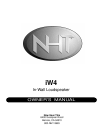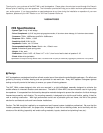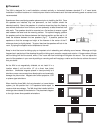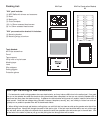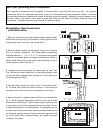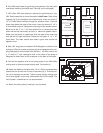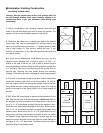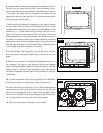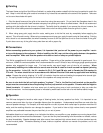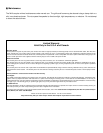Painting
The bezel frame and grille of the iW4 are finished in a matte white powder-coated finish that may be painted to match the
wall. Keep in mind that the grille contains hundreds of tiny holes that are essential to the sound of the speaker. Take care
not to cover these holes with paint.
1. Paint the bezel frame and the grille at the same time using the same paint. Do not install the fiberglass sheet in the
space formed by the acoustic foam because overspray from painting will reduce its effectiveness. We do not recommend
painting while the baffle with the drivers is installed. The baffle itself is paintable if you remove the drivers; however, the
black finish of the baffle prevents the speaker's black drive units from being visible once the grille is in place.
2. When using spray paint, apply two thin coats, making sure to let the first coat dry completely before applying the
second. This will avoid running. When using a compressor and spray gun, apply the paint using its finest setting. Painting
with a brush is not recommended, but when necessary be sure to thin the paint so as not to cover the holes in the grille.
If paint does cover any of the grille holes, poke them out with a paper clip.
Connections
Before connecting speakers to your system, it is important that you turn off the power to your amplifier / receiv-
er to avoid damage to the equipment. Before installing the iW4, map out the wiring paths between the speakers
and the amplifier. Make sure that the speaker wire does not rest on sharp or pointed objects.
The iW4 is compatible with virtually all quality amplifiers. Proper wiring of the speakers is essential to good sound. At a
minimum, 16AWG 2-conductor speaker wire is recommended for runs of 10 feet or less, with larger gauge special purpose
speaker wire suggested for longer runs. For best results, use equal length runs of wire for all speakers. When
permanently installing wire inside walls, be sure to use wire that is rated for in-wall use and has special jacketing
for fire prevention. In the U.S., the U.L. standard is CL-2, CL-3 and CM wire, and in Canada the CSA standard is
FT4 wire. The wires should be run in accordance with National Electrical Code and any applicable local building
codes. Prepare the wire by stripping 1/4" to 3/8" of insulation from the ends and twisting the exposed wire strands tight-
ly. The spring-loaded binding posts on the back of the speaker will accept raw wire only.
Be sure to wire both the left and right speakers "in-phase." That is, the Positive (red) terminal on the amplifier
output must be connected to the corresponding Positive (red) terminal on the speaker. Likewise with the Negative
(black) terminals. All speaker wire have some sort of marking along one or both conductors to help you make the
correct connections. Incorrect speaker phase is indicated by weak bass and the lack of a well-defined stereo image.
Operation
The iW4 was designed to handle a wide range of listening levels, but every speaker has limits. It is important to use
common sense and listen for signs of possible distress from the speakers. Underpowered amplifiers are most often the
cause of speaker damage. For example, a 60-watt amplifier runs out of power when called upon to produce more than 60
watts, and the resulting distortion can damage the speaker. If you tend to listen at high volume levels, more powerful
amplifiers are preferable because they are less likely to run out of power.
Noticeable distortion or harsh breakup is an indication that either your amplifier or your speakers are running beyond their
capacity, and the volume should be decreased. If you can feel any heat emanating from the woofers or tweeter, reduce
the level immediately. Speaker damage most often occurs from sustained high volume levels, not from transient sounds
or brief musical peaks. Excessive boosting of bass, treble or equalizer controls can worsen the problem, and is not
recommended.



